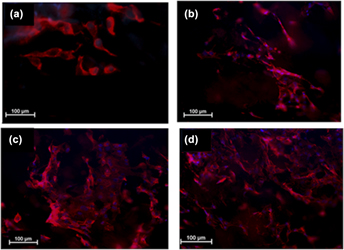Crossref Citations
This article has been cited by the following publications. This list is generated based on data provided by
Crossref.
Chircov, Cristina
and
Grumezescu, Alexandru Mihai
2019.
Materials for Biomedical Engineering.
p.
19.
Rastogi, Prasansha
and
Kandasubramanian, Balasubramanian
2019.
Review of alginate-based hydrogel bioprinting for application in tissue engineering.
Biofabrication,
Vol. 11,
Issue. 4,
p.
042001.
Datta, Sudipto
Das, Ankita
Chowdhury, Amit Roy
and
Datta, Pallab
2019.
Bioink formulations to ameliorate bioprinting-induced loss of cellular viability.
Biointerphases,
Vol. 14,
Issue. 5,
Datta, Sudipto
Barua, Ranjit
and
Das, Jonali
2020.
Alginates - Recent Uses of This Natural Polymer.
Karavasili, Christina
Tsongas, Konstantinos
Andreadis, Ioannis I.
Andriotis, Eleftherios G.
Papachristou, Eleni T.
Papi, Rigini M.
Tzetzis, Dimitrios
and
Fatouros, Dimitrios G.
2020.
Physico-mechanical and finite element analysis evaluation of 3D printable alginate-methylcellulose inks for wound healing applications.
Carbohydrate Polymers,
Vol. 247,
Issue. ,
p.
116666.
Datta, Sudipto
Das, Ankita
Sasmal, Pranabesh
Bhutoria, Sumant
Roy Chowdhury, Amit
and
Datta, Pallab
2020.
Alginate-poly(amino acid) extrusion printed scaffolds for tissue engineering applications.
International Journal of Polymeric Materials and Polymeric Biomaterials,
Vol. 69,
Issue. 2,
p.
65.
Saygili, Ecem
Dogan-Gurbuz, Asli Aybike
Yesil-Celiktas, Ozlem
and
Draz, Mohamed S.
2020.
3D bioprinting: A powerful tool to leverage tissue engineering and microbial systems.
Bioprinting,
Vol. 18,
Issue. ,
p.
e00071.
Smandri, Ali
Nordin, Abid
Hwei, Ng Min
Chin, Kok-Yong
Abd Aziz, Izhar
and
Fauzi, Mh Busra
2020.
Natural 3D-Printed Bioinks for Skin Regeneration and Wound Healing: A Systematic Review.
Polymers,
Vol. 12,
Issue. 8,
p.
1782.
Datta, Sudipto
Barua, Ranjit
and
Das, Jonali
2020.
Alginates - Recent Uses of This Natural Polymer.
Badhe, Ravindra V.
and
Nipate, Sonali S.
2020.
Advanced 3D-Printed Systems and Nanosystems for Drug Delivery and Tissue Engineering.
p.
109.
Xu, Jie
Zheng, Shuangshuang
Hu, Xueyan
Li, Liying
Li, Wenfang
Parungao, Roxanne
Wang, Yiwei
Nie, Yi
Liu, Tianqing
and
Song, Kedong
2020.
Advances in the Research of Bioinks Based on Natural Collagen, Polysaccharide and Their Derivatives for Skin 3D Bioprinting.
Polymers,
Vol. 12,
Issue. 6,
p.
1237.
Mancha Sánchez, Enrique
Gómez-Blanco, J. Carlos
López Nieto, Esther
Casado, Javier G.
Macías-García, Antonio
Díaz Díez, María A.
Carrasco-Amador, Juan Pablo
Torrejón Martín, Diego
Sánchez-Margallo, Francisco Miguel
and
Pagador, J. Blas
2020.
Hydrogels for Bioprinting: A Systematic Review of Hydrogels Synthesis, Bioprinting Parameters, and Bioprinted Structures Behavior.
Frontiers in Bioengineering and Biotechnology,
Vol. 8,
Issue. ,
Fermani, Maria
Platania, Varvara
Kavasi, Rafaela-Maria
Karavasili, Christina
Zgouro, Paola
Fatouros, Dimitrios
Chatzinikolaidou, Maria
and
Bouropoulos, Nikolaos
2021.
3D-Printed Scaffolds from Alginate/Methyl Cellulose/Trimethyl Chitosan/Silicate Glasses for Bone Tissue Engineering.
Applied Sciences,
Vol. 11,
Issue. 18,
p.
8677.
Rossi, Martina
and
Marrazzo, Pasquale
2021.
The Potential of Honeybee Products for Biomaterial Applications.
Biomimetics,
Vol. 6,
Issue. 1,
p.
6.
Angioi, Roberta
Morrin, Aoife
and
White, Blánaid
2021.
The Rediscovery of Honey for Skin Repair: Recent Advances in Mechanisms for Honey-Mediated Wound Healing and Scaffolded Application Techniques.
Applied Sciences,
Vol. 11,
Issue. 11,
p.
5192.
Sengupta, Aditya
and
Datta, Pallab
2021.
Food, Medical, and Environmental Applications of Polysaccharides.
p.
47.
Askari, Mohsen
Afzali Naniz, Moqaddaseh
Kouhi, Monireh
Saberi, Azadeh
Zolfagharian, Ali
and
Bodaghi, Mahdi
2021.
Recent progress in extrusion 3D bioprinting of hydrogel biomaterials for tissue regeneration: a comprehensive review with focus on advanced fabrication techniques.
Biomaterials Science,
Vol. 9,
Issue. 3,
p.
535.
Scepankova, Hana
Combarros-Fuertes, Patricia
Fresno, José María
Tornadijo, María Eugenia
Dias, Miguel Sousa
Pinto, Carlos A.
Saraiva, Jorge A.
and
Estevinho, Letícia M.
2021.
Role of Honey in Advanced Wound Care.
Molecules,
Vol. 26,
Issue. 16,
p.
4784.
Nazarnezhad, Simin
Hooshmand, Sara
Baino, Francesco
and
Kargozar, Saeid
2021.
3D printable Gel-inks for Tissue Engineering.
p.
191.
Saha, Sayandeep
and
Datta, Pallab
2021.
3D printable Gel-inks for Tissue Engineering.
p.
27.


